操作题自动评分系统的设计与实现
- 格式:pdf
- 大小:508.55 KB
- 文档页数:7
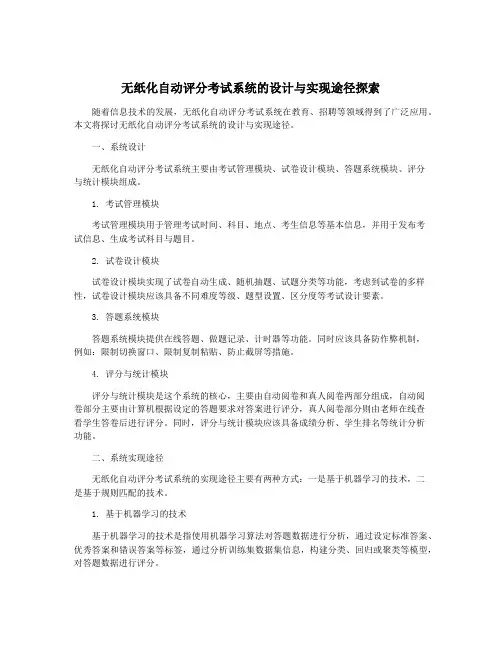
无纸化自动评分考试系统的设计与实现途径探索随着信息技术的发展,无纸化自动评分考试系统在教育、招聘等领域得到了广泛应用。
本文将探讨无纸化自动评分考试系统的设计与实现途径。
一、系统设计无纸化自动评分考试系统主要由考试管理模块、试卷设计模块、答题系统模块、评分与统计模块组成。
1. 考试管理模块考试管理模块用于管理考试时间、科目、地点、考生信息等基本信息,并用于发布考试信息、生成考试科目与题目。
2. 试卷设计模块试卷设计模块实现了试卷自动生成、随机抽题、试题分类等功能,考虑到试卷的多样性,试卷设计模块应该具备不同难度等级、题型设置、区分度等考试设计要素。
3. 答题系统模块答题系统模块提供在线答题、做题记录、计时器等功能。
同时应该具备防作弊机制,例如:限制切换窗口、限制复制粘贴、防止截屏等措施。
4. 评分与统计模块评分与统计模块是这个系统的核心,主要由自动阅卷和真人阅卷两部分组成,自动阅卷部分主要由计算机根据设定的答题要求对答案进行评分,真人阅卷部分则由老师在线查看学生答卷后进行评分。
同时,评分与统计模块应该具备成绩分析、学生排名等统计分析功能。
二、系统实现途径无纸化自动评分考试系统的实现途径主要有两种方式:一是基于机器学习的技术,二是基于规则匹配的技术。
1. 基于机器学习的技术基于机器学习的技术是指使用机器学习算法对答题数据进行分析,通过设定标准答案、优秀答案和错误答案等标签,通过分析训练集数据集信息,构建分类、回归或聚类等模型,对答题数据进行评分。
目前,常见的机器学习算法包括逻辑回归、支持向量机、随机森林、人工神经网络等,这些算法应根据具体应用需求选择使用。
同时,基于机器学习的技术还可以采用自然语言处理、图像识别等技术进行答题评分。
2. 基于规则匹配的技术基于规则匹配的技术是指根据设定的评分规则、参考答案、白名单、黑名单等制定评分规则,对答题数据进行匹配评分。
这种方法主要使用正则表达式、深度学习等技术,在处理大规模答卷数据时具有较高的效率。
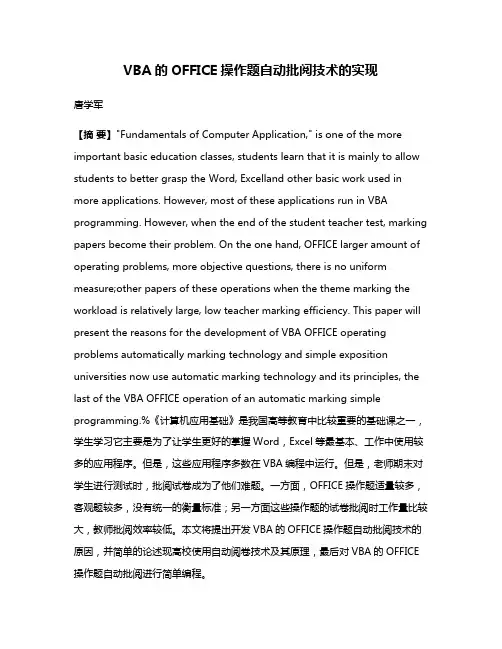
VBA的OFFICE操作题自动批阅技术的实现唐学军【摘要】"Fundamentals of Computer Application," is one of the more important basic education classes, students learn that it is mainly to allow students to better grasp the Word, Excelland other basic work used in more applications. However, most of these applications run in VBA programming. However, when the end of the student teacher test, marking papers become their problem. On the one hand, OFFICE larger amount of operating problems, more objective questions, there is no uniform measure;other papers of these operations when the theme marking the workload is relatively large, low teacher marking efficiency. This paper will present the reasons for the development of VBA OFFICE operating problems automatically marking technology and simple exposition universities now use automatic marking technology and its principles, the last of the VBA OFFICE operation of an automatic marking simple programming.%《计算机应用基础》是我国高等教育中比较重要的基础课之一,学生学习它主要是为了让学生更好的掌握Word,Excel等最基本、工作中使用较多的应用程序。
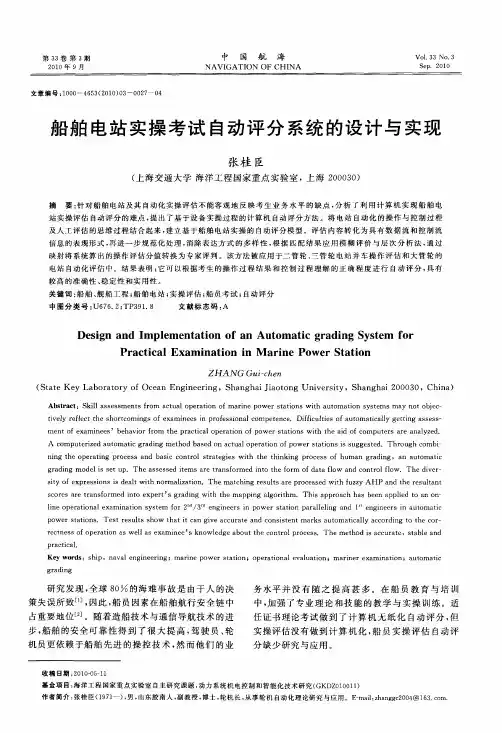
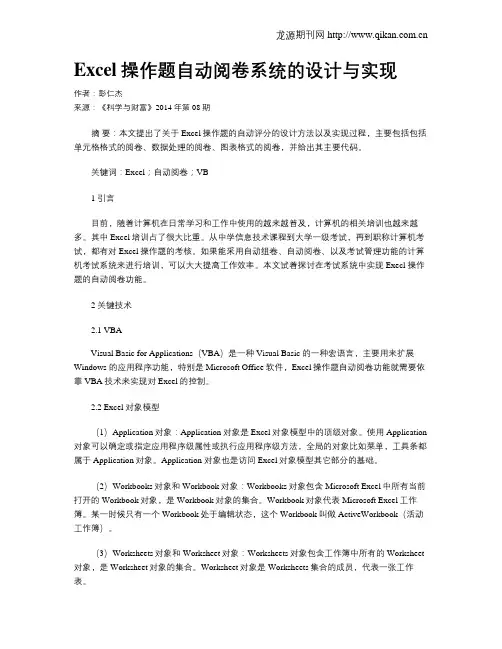
Excel操作题自动阅卷系统的设计与实现作者:彭仁杰来源:《科学与财富》2014年第08期摘要:本文提出了关于Excel操作题的自动评分的设计方法以及实现过程,主要包括包括单元格格式的阅卷、数据处理的阅卷、图表格式的阅卷,并给出其主要代码。
关键词:Excel;自动阅卷;VB1 引言目前,随着计算机在日常学习和工作中使用的越来越普及,计算机的相关培训也越来越多。
其中Excel培训占了很大比重。
从中学信息技术课程到大学一级考试,再到职称计算机考试,都有对Excel操作题的考核。
如果能采用自动组卷、自动阅卷、以及考试管理功能的计算机考试系统来进行培训,可以大大提高工作效率。
本文试着探讨在考试系统中实现Execl 操作题的自动阅卷功能。
2 关键技术2.1 VBAVisual Basic for Applications(VBA)是一种Visual Basic 的一种宏语言,主要用来扩展Windows 的应用程序功能,特别是Microsoft Office 软件,Excel操作题自动阅卷功能就需要依靠VBA技术来实现对Excel的控制。
2.2 Excel对象模型(1)Application对象:Application对象是Excel对象模型中的顶级对象。
使用Application 对象可以确定或指定应用程序级属性或执行应用程序级方法,全局的对象比如菜单,工具条都属于Application对象。
Application 对象也是访问Excel对象模型其它部分的基础。
(2)Workbooks对象和Workbook对象:Workbooks对象包含Microsoft Excel中所有当前打开的Workbook对象,是Workbook对象的集合。
Workbook对象代表Microsoft Excel工作簿。
某一时候只有一个Workbook处于编辑状态,这个Workbook叫做ActiveWorkbook(活动工作簿)。
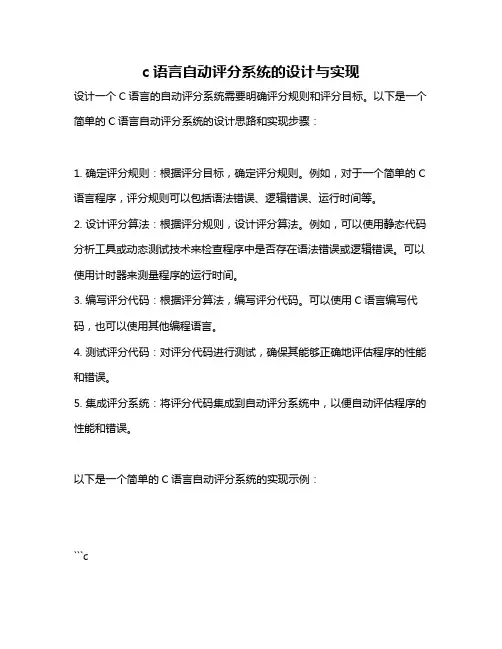
c语言自动评分系统的设计与实现设计一个C语言的自动评分系统需要明确评分规则和评分目标。
以下是一个简单的C语言自动评分系统的设计思路和实现步骤:1. 确定评分规则:根据评分目标,确定评分规则。
例如,对于一个简单的C 语言程序,评分规则可以包括语法错误、逻辑错误、运行时间等。
2. 设计评分算法:根据评分规则,设计评分算法。
例如,可以使用静态代码分析工具或动态测试技术来检查程序中是否存在语法错误或逻辑错误。
可以使用计时器来测量程序的运行时间。
3. 编写评分代码:根据评分算法,编写评分代码。
可以使用C语言编写代码,也可以使用其他编程语言。
4. 测试评分代码:对评分代码进行测试,确保其能够正确地评估程序的性能和错误。
5. 集成评分系统:将评分代码集成到自动评分系统中,以便自动评估程序的性能和错误。
以下是一个简单的C语言自动评分系统的实现示例:```cinclude <>include <>include <>include <>define MAX_LINE_LENGTH 1000define MAX_ERRORS 10int main(int argc, char argv[]) {FILE fp;char line[MAX_LINE_LENGTH];int line_num = 1;int error_count = 0;clock_t start_time, end_time;double elapsed_time;if (argc != 2) {printf("Usage: %s <file>\n", argv[0]); exit(1);}fp = fopen(argv[1], "r");if (fp == NULL) {printf("Error: could not open file %s\n", argv[1]);exit(1);}while (fgets(line, MAX_LINE_LENGTH, fp) != NULL) { // Check for syntax errorsif (strstr(line, "error") != NULL) {error_count++;printf("Error on line %d: %s\n", line_num, line); }line_num++;}fclose(fp);if (error_count > MAX_ERRORS) {printf("Too many errors (%d > %d)\n", error_count, MAX_ERRORS);exit(1);} else if (error_count > 0) {printf("Program contains %d error%s.\n", error_count,error_count > 1 ? "s" : "");exit(0); // return 0 for success, 1 for failure} else {printf("Program is free of errors.\n");exit(0); // return 0 for success, 1 for failure}}```该程序接受一个参数,即要评估的C语言源代码文件名。
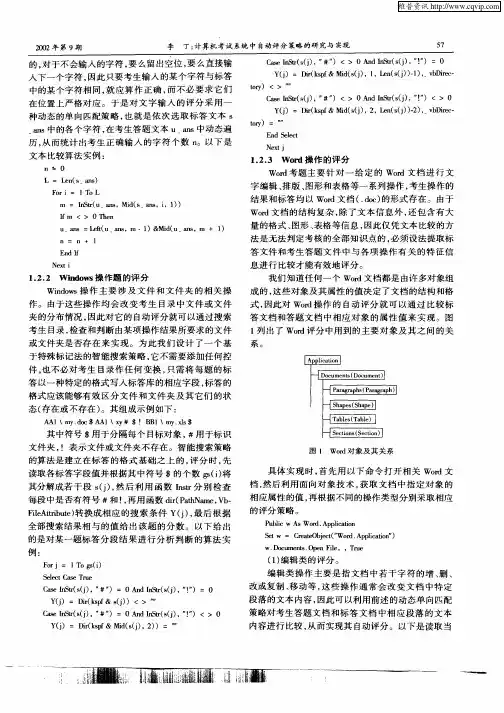
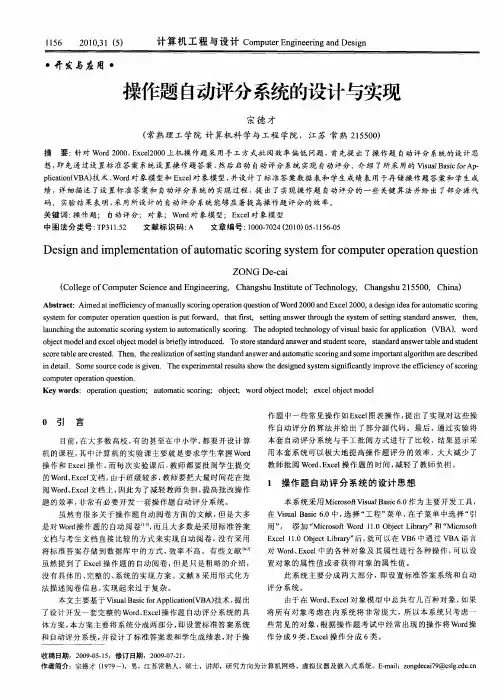
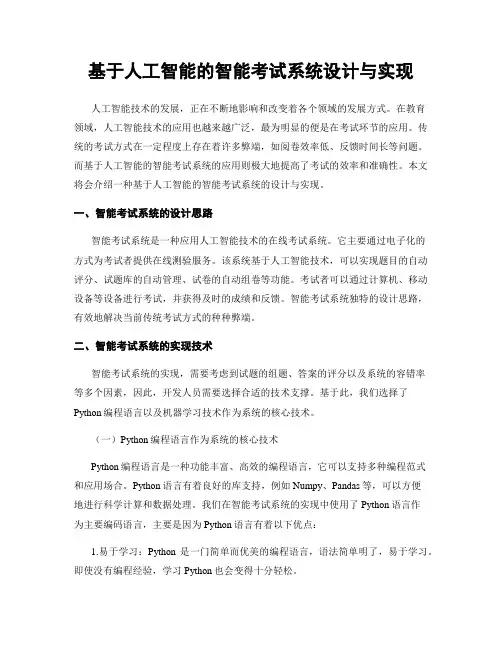
基于人工智能的智能考试系统设计与实现人工智能技术的发展,正在不断地影响和改变着各个领域的发展方式。
在教育领域,人工智能技术的应用也越来越广泛,最为明显的便是在考试环节的应用。
传统的考试方式在一定程度上存在着许多弊端,如阅卷效率低、反馈时间长等问题。
而基于人工智能的智能考试系统的应用则极大地提高了考试的效率和准确性。
本文将会介绍一种基于人工智能的智能考试系统的设计与实现。
一、智能考试系统的设计思路智能考试系统是一种应用人工智能技术的在线考试系统。
它主要通过电子化的方式为考试者提供在线测验服务。
该系统基于人工智能技术,可以实现题目的自动评分、试题库的自动管理、试卷的自动组卷等功能。
考试者可以通过计算机、移动设备等设备进行考试,并获得及时的成绩和反馈。
智能考试系统独特的设计思路,有效地解决当前传统考试方式的种种弊端。
二、智能考试系统的实现技术智能考试系统的实现,需要考虑到试题的组题、答案的评分以及系统的容错率等多个因素,因此,开发人员需要选择合适的技术支撑。
基于此,我们选择了Python编程语言以及机器学习技术作为系统的核心技术。
(一)Python编程语言作为系统的核心技术Python编程语言是一种功能丰富、高效的编程语言,它可以支持多种编程范式和应用场合。
Python语言有着良好的库支持,例如Numpy、Pandas等,可以方便地进行科学计算和数据处理。
我们在智能考试系统的实现中使用了Python语言作为主要编码语言,主要是因为Python语言有着以下优点:1.易于学习:Python是一门简单而优美的编程语言,语法简单明了,易于学习。
即使没有编程经验,学习Python也会变得十分轻松。
2.跨平台性:Python可以在各种操作系统上运行,包括Windows、Mac、Linux 等。
这种特性让开发者可以使用一种语言跨多个平台开发应用。
3.大量库支持:Python有着庞大的官方库和第三方库,包括Numpy、Pandas等,这些库提供的API和函数可以大大简化开发的工作。
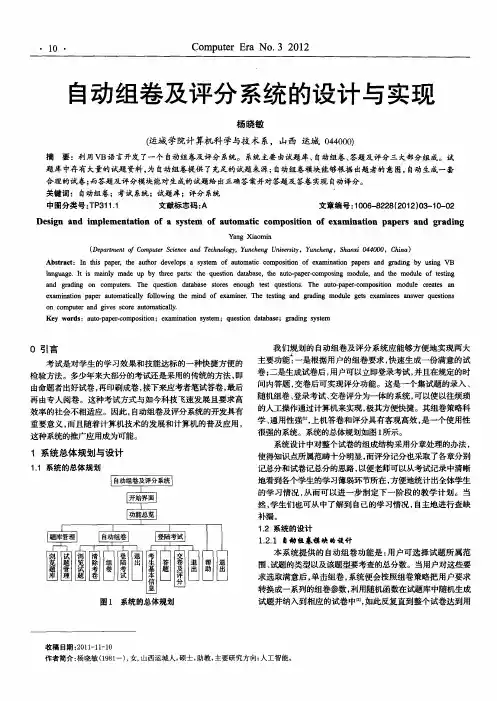

无纸化自动评分考试系统的设计与实现途径探索1. 引言1.1 背景介绍随着信息技术的迅速发展和教育领域的不断创新,传统的纸质考试方式逐渐暴露出诸多问题,比如阅卷过程繁琐、容易出现人为偏差、无法及时反馈学生表现等。
开发一种无纸化自动评分考试系统成为当下教育行业的迫切需求。
传统的纸质考试方式需要大量的人力和物力投入,不仅费时费力,而且难以做到及时准确的评分,容易引发争议;而无纸化自动评分考试系统可以通过计算机技术实现试卷的自动化生成、考试的监控和记录、答案的自动评分等功能,极大地提高了工作效率和评分准确性。
随着人工智能技术的不断发展,自动评分算法也得到了很大的提升,更加精准可靠。
研究和设计一套稳定可靠的无纸化自动评分考试系统将有助于提高教育考核的公平性和科学性,促进学生的学习动力和教师的教学水平,是当前教育技术领域的一个重要研究课题。
1.2 研究目的研究目的主要是针对传统纸质考试存在的诸多问题,比如考试过程中可能出现的作弊现象、评分不公平、评分效率低下等方面进行改进和优化。
通过引入无纸化自动评分考试系统,旨在提高考试的公平性、科学性和效率,为教育教学工作提供更加便捷、准确和可靠的评价手段。
具体来说,研究目的包括:1.探索如何利用现代信息技术手段构建起一套高效准确的无纸化自动评分考试系统,实现试卷的电子化和评分的自动化。
2.研究如何设计合理的考试流程和评分标准,确保考试过程公平公正,并且评分结果准确可信。
3.研究如何应用自动评分算法和技术,提高评分效率,减少评分主观性,确保评分结果的客观性和一致性。
4.分析无纸化自动评分考试系统在实际教学实践中的应用前景和可能存在的问题,探索系统的持续优化和改进方向。
1.3 研究意义无纸化自动评分考试系统的设计与实现对于教育教学领域具有重要意义。
该系统能够提高教育教学的效率和质量。
传统的手工评分考试存在着评分时间长、人力成本高、容易出现评分差异等问题,而自动评分能够快速、准确地完成评分,节省了教师的时间和精力,同时还能够减少评分差异,提高评分的客观性和公正性。
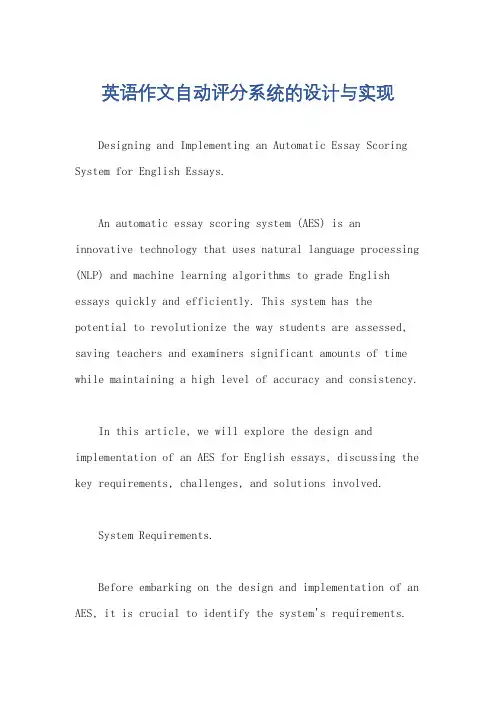
英语作文自动评分系统的设计与实现Designing and Implementing an Automatic Essay Scoring System for English Essays.An automatic essay scoring system (AES) is an innovative technology that uses natural language processing (NLP) and machine learning algorithms to grade English essays quickly and efficiently. This system has the potential to revolutionize the way students are assessed, saving teachers and examiners significant amounts of time while maintaining a high level of accuracy and consistency.In this article, we will explore the design and implementation of an AES for English essays, discussing the key requirements, challenges, and solutions involved.System Requirements.Before embarking on the design and implementation of an AES, it is crucial to identify the system's requirements.These requirements typically include:1. Language Support: The system should be able tohandle English essays, recognizing and understanding the nuances of the language.2. Content Analysis: The system should analyze theessay's content, looking for key elements such as coherence, organization, and grammar.3. Scoring Rubric: A clear scoring rubric should be established to guide the grading process, ensuring fairness and consistency.4. Scalability: The system should be able to handle a large volume of essays without compromising performance.5. User-friendliness: The system should have anintuitive user interface that is easy to navigate and use.Challenges and Solutions.Designing and implementing an AES for English essays presents several challenges, which can be addressed through innovative solutions:1. Language Complexity: English is a highly complex language with a rich vocabulary, syntax, and semantics. To address this challenge, the system can leverage advanced NLP techniques such as word embeddings and deep learning models. These techniques help the system capture the contextual meaning of words and phrases, enabling it to better understand the essay's content.2. Subjectivity in Grading: Essay grading can be subjective, as different teachers or examiners mayinterpret the same essay differently. To address this issue, the system can be trained using a large dataset of essays graded by multiple experts. By learning from multiple grading perspectives, the system can develop a more nuanced understanding of grading standards and reduce subjectivity.3. Scalability: Handling a large volume of essays canbe computationally intensive, potentially affecting systemperformance. To address this challenge, the system can employ distributed computing techniques, such as cloud computing or parallel processing. These techniques enable the system to distribute the grading workload acrossmultiple servers or computing units, improving scalability and performance.4. Feedback Generation: Providing constructive feedback to students is crucial for their learning and development. The system can generate feedback by analyzing the essay's strengths and weaknesses, identifying areas for improvement, and suggesting specific strategies or techniques. This feedback can be presented in a clear and actionable format, helping students understand their performance and make informed decisions about their future writing.Implementation.The implementation of an AES for English essaystypically involves several stages:1. Data Collection: Gather a large dataset of Englishessays, including both student submissions and expert gradings. This dataset should be diverse and representative of the range of essay topics and grading standards.2. Preprocessing: Clean and preprocess the collected data, removing any irrelevant or noisy information. This step may include tokenization, sentence segmentation, and removing stop words or punctuation marks.3. Feature Extraction: Extract relevant features from the preprocessed data that can be used for grading. These features may include word counts, sentence lengths, part-of-speech tags, or more complex features derived from NLP techniques such as word embeddings or semantic analysis.4. Model Training: Train a machine learning model using the extracted features and corresponding expert gradings. Various algorithms can be experimented with, such as regression models (e.g., linear regression, support vector regression), decision trees, or deep learning models (e.g., recurrent neural networks, transformers).5. Model Evaluation: Evaluate the trained model's performance using appropriate evaluation metrics such as correlation coefficients (e.g., Pearson's r), mean absolute error (MAE), or root mean squared error (RMSE). Compare the model's performance against human graders to assess its validity and reliability.6. Deployment and Integration: Deploy the trained model into a user-friendly interface that integrates withexisting learning management systems or online platforms. Ensure that the system is accessible and easy to use for both teachers and students.7. Ongoing Monitoring and Improvement: Continuously monitor the system's performance and gather feedback from users to identify any issues or areas for improvement. Regularly update and retrain the model using new data to maintain its accuracy and relevance.In conclusion, an automatic essay scoring system for English essays has the potential to revolutionize the way students are assessed. By leveraging advanced NLPtechniques and machine learning algorithms, this system can grade essays quickly, efficiently, and with a high level of accuracy and consistency. However, its design and implementation involve several challenges that need to be addressed through innovative solutions. By continuously monitoring and improving the system, we can ensure that it remains effective and relevant in supporting student learning and assessment.。
Word操作自动评分系统的设计与实现高家宝;周娅【摘要】With the further development of information, it puts forward new requirements for assessment of all kinds of information curriculum, and the assessment of the Office software operating subjects of computer application basic courses is the key point.This kind of assessment with artificial marking needs to consume a large amount of energy, in order to reduce the teacher's burden of setting a question and grading, developing a scoring system of automatic marking Office subjects is necessary.The Automatic Marking System based on Client/Server structure and used C# programming language to analyze various object attributes of Word document, given the automatic marking mechanism and the main algorithm, and achieved the automatic marking function for the Word document operation questions.%随着信息化的进一步发展,对各类信息课程的考核提出了新的要求,其中计算机应用基础课程中的Office软件的操作类题目的考核是一个重点.这类考核采用人工评卷需要消耗大量的精力,为了减轻教师的阅卷和出题负担,开发一个能够自动评阅Office类题目的评分系统是必要的.本文主要实现一个Word自动评分系统,Word自动评分系统采用了Client/Server结构,利用C#编程语言对Word文档的各种对象属性进行分析,给出了自动评分的机制和主要算法,实现了Word文档操作题自动评分功能.【期刊名称】《河池学院学报》【年(卷),期】2017(037)002【总页数】7页(P94-100)【关键词】Word操作;自动评分;系统设计;C#【作者】高家宝;周娅【作者单位】桂林电子科技大学计算机与信息安全学院,广西桂林 541004;河池学院现代教育技术中心,广西宜州 546300;桂林电子科技大学计算机与信息安全学院,广西桂林 541004【正文语种】中文【中图分类】TP311.51随着计算机技术迅猛发展,计算机技术已经成为人们日常生活中的一个重要组成部分。
无纸化自动评分考试系统的设计与实现途径探索一、系统架构设计一个完善的无纸化自动评分考试系统不仅要具备考试题目录入、考生信息管理、答题卡识别和评分等基本功能,还应该考虑到考试过程的监控、数据安全和成绩发布等方面。
系统架构设计是无纸化自动评分考试系统设计与实现的第一步。
1. 考试题目录入模块考试题目的录入是无纸化自动评分考试系统的基础,可以通过Excel表格导入或者手动输入的方式将考试题目、选项和答案录入到系统中,并提供题目分类和难度级别设置的功能,方便后续的试卷生成和试题分析。
2. 考生信息管理模块考生信息管理模块应该包括考生信息的录入、修改和查询功能,同时还应该提供考生身份验证和考试报名确认的功能,确保考试的安全性和公平性。
3. 试卷生成和分发模块无纸化自动评分考试系统应该具备随机生成试卷的功能,保证每个考生所得到的试卷内容不同,避免作弊行为的发生。
还需要提供试卷分发的功能,可以通过电子邮件或者系统内消息的方式将试卷发送给考生。
4. 答题卡识别和评分模块答题卡识别和评分模块是无纸化自动评分考试系统的核心功能,应该支持多种题型的自动识别和评分,包括选择题、填空题和简答题等。
还应该提供手工评阅和成绩调整的功能,确保评分的准确性和公平性。
5. 考试监控和数据分析模块考试监控和数据分析模块可以监测考试的进行情况,实时掌握考生的答题情况和作弊行为,同时还可以对考试结果进行统计和分析,为教学质量和教学改进提供数据支撑。
6. 数据安全和成绩发布模块数据安全和成绩发布模块应该保障考试数据的安全和机密性,防止数据泄露和篡改,同时还要提供成绩查询和打印成绩单的功能,满足学生和家长的需求。
二、实现途径探索实现无纸化自动评分考试系统需要运用多项技术和工具,包括图像识别技术、大数据分析技术、人工智能技术和云计算技术等。
下面将分别介绍这些技术在无纸化自动评分考试系统中的应用。
1. 图像识别技术图像识别技术可以用于答题卡的识别和评分,通过扫描答题卡并识别其中的填涂情况,然后将识别结果与系统中存储的答案进行比对,最终得出考生的得分。
考试系统中操作题自动评分的设计与实现史娟【摘要】目前的计算机考试系统大多数是采用标准答案文档与考生文档直接比对的方式来实现操作题的自动阅卷,评分效率不高,成绩容易出现误差.针对这一现象,以Word 2003操作题为例,提出了改进的思路及具体的实现方法,即基于VBA技术和Word对象模型,采用将标准答案存储到数据库中的方式,利用设置好的标准答案数据库,启动自动评分系统对操作题进行自动评分.实验结果表明,采用此方法设计的评分系统,平均30s左右就可以实现一个文档的自动评分,显著提高了操作题的评分效率.%At present, the standard answer document is adopted to directly compare with the candidate documents to realize the operational problems automatic scoring in most of the computer examination systems, in which the scoring efficiency is not high and scoring results prone to error. In view of this phenomenon, taking Word 2003 operating problem as an example, an idea for improvement and a specific realization method for scoring are put forward. The method is based on visual basic for application (VBA) technology and Word object model. In this way, the standard answers are stored in the database, and the automatic scoring system conducts the automatic scoring of operation problems by means of the standard answer database. The experimental results show that the automatic scoring system designed in this way can fulfil a candidate's document scoring in about 30 s automatically. It significantly improved the scoring efficiency of operation questions.【期刊名称】《现代电子技术》【年(卷),期】2012(035)014【总页数】4页(P33-36)【关键词】考试系统;自动评分;VBA;Word对象模型【作者】史娟【作者单位】青海建筑职业技术学院,青海西宁810012【正文语种】中文【中图分类】TN919-34;TP310 引言随着计算机应用技术和网络技术的不断发展,利用计算机考试正在逐渐取代传统的考试模式。
Word操作题课件中自动评分功能的实现一、问题的提出:由于信息技术学科要参加中考,我们学校的机房里安装了一款自动化考试软件,学生答题完成后,评分系统可以自动反馈答题结果,帮助学生发现错误,受到学生的广泛欢迎。
但是,每周只有一节课的练习时间显然不够,所以很多学生希望能将考试题目复制到家里的电脑中,周末可以抽出时间来做题目。
显然,将考试系统安装到学生家庭电脑中成本太高,也很麻烦。
能不能将操作题做成课件发给学生呢?通过对相关技术要素进行分析,我们发现,由信息技术教师来制作这样的课件是可行的。
本文以Word 2000基本操作的课件为例,谈谈自动评分的基本思路和实现方法,Excel、PowerPoint等软件操作题自动评分的实现也可以参考本文的方法实现。
二、课件的基本要求:由于Word操作题课件仅用于学生对自己所学操作的自查自测,所以课件应尽量满足以下要求:(1)不需要其他服务的支持;(2)可以重复使用,课件要保证原始文档不被破坏;(3)操作方便,不需安装,双击即可运行。
为满足以上要求,课件必须能将原始文档、操作要求、评分功能集成于一个可执行文件中。
三、课件的设计思路和实现方法:采用VB作为课件的开发平台。
1.原始文档资源的封装和提取方法:在课件未运行时,原始的Word文档对学生应该是不可见的,所以,应该将Word文档以资源文件集成于可执行文件中,在课件运行时,提取出文档后存储于工作文件夹中,课件关闭时,再删除文档。
(1)打开VB资源编辑器窗口,添加“自定义资源”,选择原始文档。
如上图1,“CUSTOM”为自定义资源文件夹,“101”为该资源的编号。
保存自定义资源后,在“工程资源管理器”窗口中可以看到“工程1.RES”,如图2。
(2)在课件程序运行时,提取文件到工作目录中,见下面代码及注释:path = App.path '将应用程序目录作为课件的工作目录Const ExeFile = 33280 '33280是欲生成的文件的字节数Dim ExeMy() As Byte 'Btye类型的数组,存放EXE文件Dim Counter As Long '文件字节数'将文件读入数组ExeMy = LoadResData(101, "CUSTOM") '读取编号为101的自定义资源文件Open path & "\wordtest.doc" For Binary As #1'从0 Byte开始因此以文件大小- 1Byte 为终值For Counter = 0 To ExeFile - 1Put #1, , ExeMy(Counter) '释放文件Next CounterClose #12.识别Word文档对象(1)基本思路:利用VBA提供的访问Word文档的接口,使用VBA编程可以识别、控制Word 文档的格式。